Induced Polarisation Surveys
Induced Polarisation (IP) is a survey technique where electrodes induce and measure a potential field in the ground. From this data, the soil chargeability and apparent resistivity can be measured.
Gap Geophysics Australia specialises in the acquisition of very high quality IP data using the industry standard EMIT SMARTem24 System coupled with advanced Gap GeoPak Geophysical Transmitters.
Our IP surveys typically use high voltage GeoPak IPTX-2500 or high power HPTX-70/80 transmitters as the signal source, depending on ground conditions.

For IP applications, the SMARTem24 is capable of simultaneous acquisition of up to 16 channels of data from one spread using multi-core cables. The picture shows the SMARTem24 and the 16-channel external breakout box.
The IPTX-2500 is a modular transmitter which can be powered by a range of DC sources including the DC8MV, DC10HV and DV14HV (shown) generators or a PS30HV 3-phase power supply.
The IPTX-2500 is capable of output power of up to 30kW, output current up to 50A, and output voltage up to 2500V.

IP Array Types
IP surveys can be acquired using a multitude of array types. The most common arrays are shown in the figure below and include:
- Dipole – Dipole
- Pole – Dipole
- Pole – Pole
- Gradient
- Schlumberger
- Wenner
Electrical current is transferred directly into the ground through electrodes spaced as shown in the array. The current electrode is shifted each reading whilst the array can either “rollalong” or remain fixed depending on array type.


